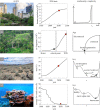Ecological complexity and the biosphere: the next 30 years
- PMID: 35757877
- PMCID: PMC9234814
- DOI: 10.1098/rstb.2021.0376
Ecological complexity and the biosphere: the next 30 years
Abstract
Global warming, habitat loss and overexploitation of limited resources are leading to alarming biodiversity declines. Ecosystems are complex adaptive systems that display multiple alternative states and can shift from one to another in abrupt ways. Some of these tipping points have been identified and predicted by mathematical and computational models. Moreover, multiple scales are involved and potential mitigation or intervention scenarios are tied to particular levels of complexity, from cells to human-environment coupled systems. In dealing with a biosphere where humans are part of a complex, endangered ecological network, novel theoretical and engineering approaches need to be considered. At the centre of most research efforts is biodiversity, which is essential to maintain community resilience and ecosystem services. What can be done to mitigate, counterbalance or prevent tipping points? Using a 30-year window, we explore recent approaches to sense, preserve and restore ecosystem resilience as well as a number of proposed interventions (from afforestation to bioengineering) directed to mitigate or reverse ecosystem collapse. The year 2050 is taken as a representative future horizon that combines a time scale where deep ecological changes will occur and proposed solutions might be effective. This article is part of the theme issue 'Ecological complexity and the biosphere: the next 30 years'.
Keywords: biodiversity; bioengineering; climate change; ecological networks; restoration; tipping points.
Figures


References
-
- Solé R, Bascompte J. 2007. Self-organization in complex ecosystems. Princeton, NJ: Princeton University Press.
Publication types
MeSH terms
LinkOut - more resources
Full Text Sources
